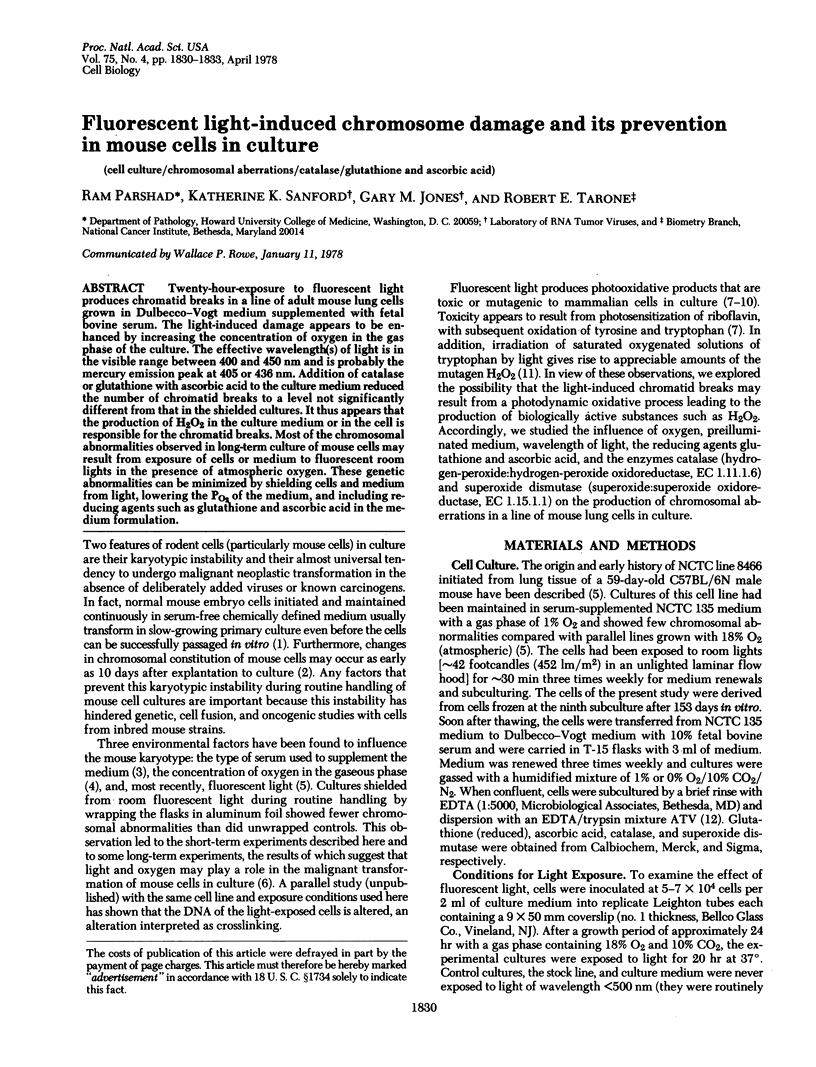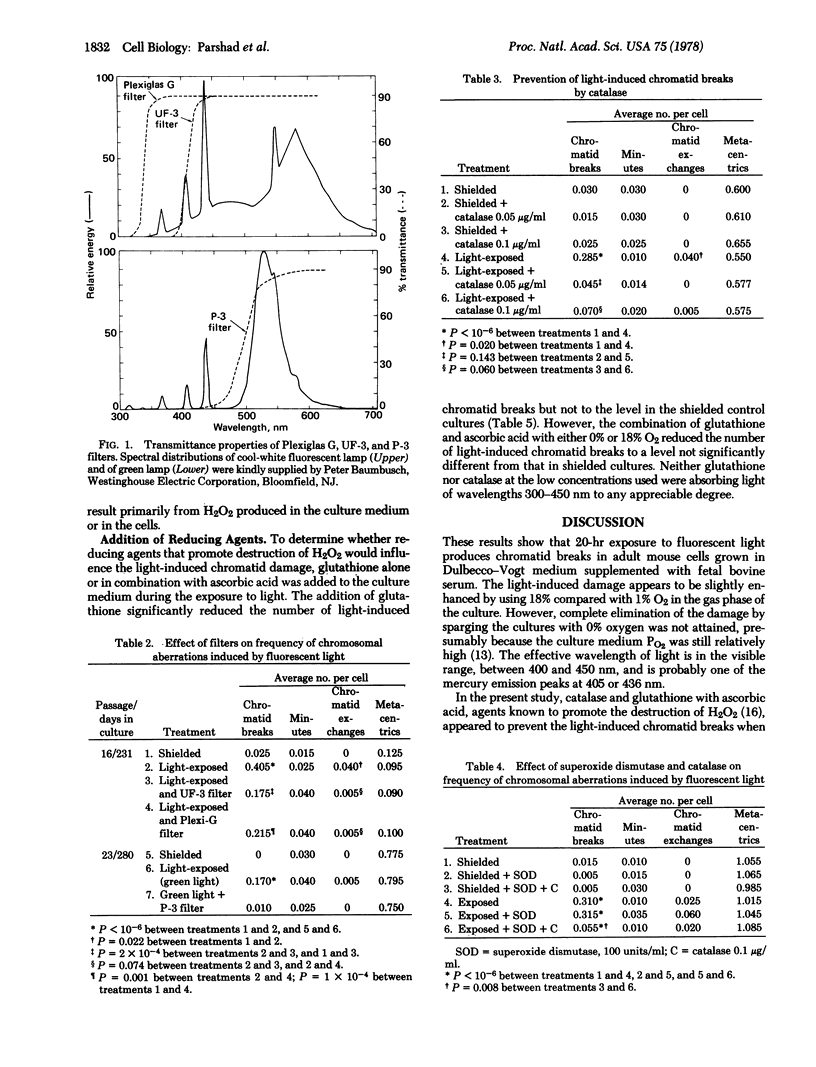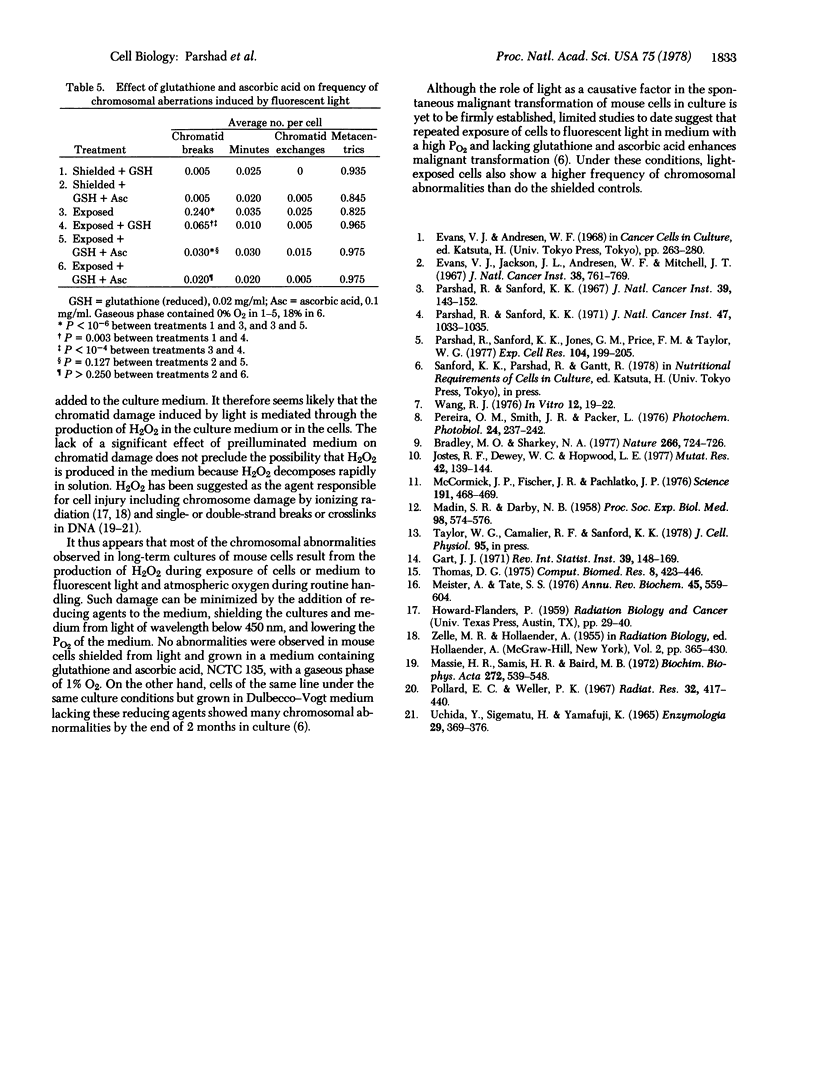Abstract
Twenty-hour-exposure to fluorescent light produces chromatid breaks in a line of adult mouse lung cells grown in Dulbecco-Vogt medium supplemented with fetal bovine serum. The light-induced damage appears to be enhanced by increasing the concentration of oxygen in the gas phase of the culture. The effective wavelength(s) of light is in the visible range between 400 and 450 nm andis probably the mercury emission peak at 405 or 436 nm. Addition of catalase or glutathione with ascorbic acid to the culture medium reduced the number of chromatid breaks to a level not significantly different from that in the shielded cultures. It thus appears that the production of H2O2 in the culture medium or in the cell is responsible for the chromatid breaks. Most of the chromosomal abnormalities observed in long-term culture of mouse cells may result from exposure of cells or medium to fluorescent room lights in the presence of atmospheric oxygen. These genetic abnormalities can be minimized by shielding cells and medium from light, lowering the PO2 of the medium, and including reducing agents such as glutathione and ascorbic acid in the medium formulation.
Full text
PDF



Selected References
These references are in PubMed. This may not be the complete list of references from this article.
- Bradley M. O., Sharkey N. A. Mutagenicity and toxicity of visible fluorescent light to cultured mammalian cells. Nature. 1977 Apr 21;266(5604):724–726. doi: 10.1038/266724a0. [DOI] [PubMed] [Google Scholar]
- Evans V. J., Jackson J. L., Andresen W. F., Mitchell J. T. Chromosomal characteristics and neoplastic transformation of C3H mouse embryo cells in vitro in horse and fetal calf serum. J Natl Cancer Inst. 1967 May;38(5):761–769. [PubMed] [Google Scholar]
- Jostes R. F., Dewey W. C., Hopwood L. E. Mutagenesis by fluorescent light in mammalian cell cultures. Mutat Res. 1977 Jan;42(1):139–144. doi: 10.1016/s0027-5107(77)80018-3. [DOI] [PubMed] [Google Scholar]
- MADIN S. H., DARBY N. B., Jr Established kidney cell lines of normal adult bovine and ovine origin. Proc Soc Exp Biol Med. 1958 Jul;98(3):574–576. doi: 10.3181/00379727-98-24111. [DOI] [PubMed] [Google Scholar]
- Massie H. R., Samis H. V., Baird M. B. The kinetics of degradation of DNA and RNA by H 2 O 2 . Biochim Biophys Acta. 1972 Jul 31;272(4):539–548. doi: 10.1016/0005-2787(72)90509-6. [DOI] [PubMed] [Google Scholar]
- McCormick J. P., Fischer J. R., Pachlatko J. P., Eisenstark A. Characterization of a cell-lethal product from the photooxidation of tryptophan: hydrogen peroxide. Science. 1976 Feb 6;191(4226):468–469. doi: 10.1126/science.1108203. [DOI] [PubMed] [Google Scholar]
- Meister A., Tate S. S. Glutathione and related gamma-glutamyl compounds: biosynthesis and utilization. Annu Rev Biochem. 1976;45:559–604. doi: 10.1146/annurev.bi.45.070176.003015. [DOI] [PubMed] [Google Scholar]
- Parshad R., Sanford K. K. Effect of horse serum and fetal calf serum on stability of chromosomes in mouse embryo cells in vitro. J Natl Cancer Inst. 1967 Jul;39(1):143–152. [PubMed] [Google Scholar]
- Parshad R., Sanford K. K., Jones G. M., Price F. M., Taylor W. G. Oxygen and light effects on chromosomal aberrations in mouse cells in vitro. Exp Cell Res. 1977 Jan;104(1):199–205. doi: 10.1016/0014-4827(77)90082-9. [DOI] [PubMed] [Google Scholar]
- Parshad R., Sanford K. K. Oxygen supply and stability of chromosomes in mouse embryo cells in vitro. J Natl Cancer Inst. 1971 Nov;47(5):1033–1035. [PubMed] [Google Scholar]
- Pereira O. M., Smith J. R., Packer L. Photosensitization of human diploid cell cultures by intracellular flavins and protection by antioxidants. Photochem Photobiol. 1976 Sep;24(3):237–242. doi: 10.1111/j.1751-1097.1976.tb06817.x. [DOI] [PubMed] [Google Scholar]
- Pollard E. C., Weller P. K. Chain scission of ribonucleic acid and deoxyribonucleic acid by ionizing radiation and hydrogen peroxide in vitro and in Escherichia coli cells. Radiat Res. 1967 Nov;32(3):417–440. [PubMed] [Google Scholar]
- Thomas D. G. Exact and asymptotic methods for the combination of 2 times 2 tables. Comput Biomed Res. 1975 Oct;8(5):423–446. doi: 10.1016/0010-4809(75)90048-8. [DOI] [PubMed] [Google Scholar]
- Uchida Y., Shigematu H., Yamafuji K. The mode of action of hydrogen peroxide on deoxyribonucleic acid. Enzymologia. 1965 Dec 31;29(6):369–376. [PubMed] [Google Scholar]
- Wang R. J. Effect of room fluorescent light on the deterioration of tissue culture medium. In Vitro. 1976 Jan;12(1):19–22. doi: 10.1007/BF02832788. [DOI] [PubMed] [Google Scholar]


